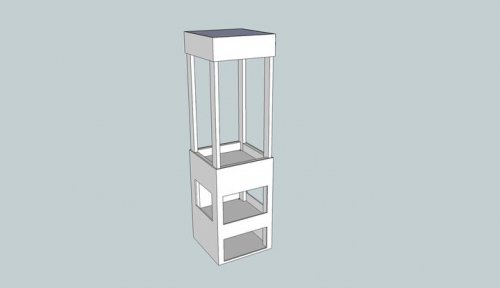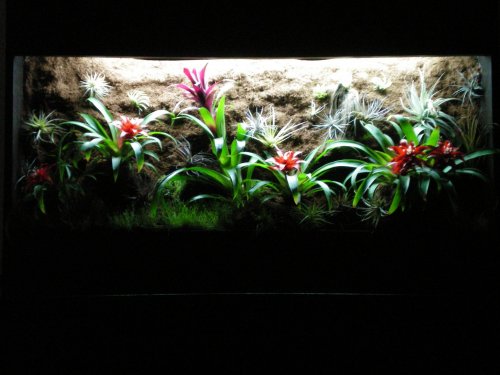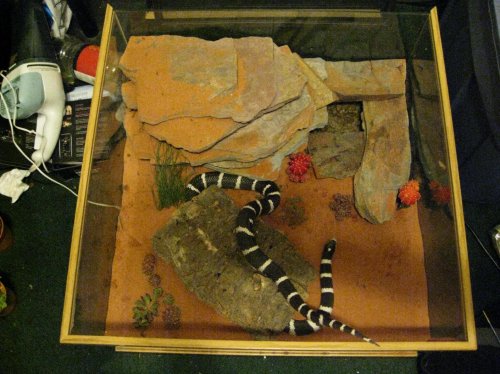Hello all,
Longtime herp keeper, planning my first chameleon soon. I have been designing a cage for him before I get him and have it mostly worked out....but I have run into a few problems, but mainly a major one:
What wood/sealer can I use that is safe for the chameleon, but will also resist repeated mistings and the like everyday? I plan on planting live plants in the enclosure as well. I ask this because I am 99% sure that if I use something like Pine, the entire thing will collapse of rot within a few months at most....I considered Teak, but it is WAY too expensive! My only requirement is that the wood MUST be stainable (I have heard Melamine is a good option, but I believe it is not stainable and therefore fails).
Secondarily, although in my design the back of the cage is open, in reality it will go up against a wall; also, I need a way to hide my misting tubes and power cords, so I am heavily considering adding a background. However, I realize most of you don't do this.....may I ask why? The only thing I could think of is an issue with the chameleon eating the dirt; do/would they pick at the foam? What about the kitty litter method? Any info on this would be appreciated.
I have attached a photo of my 3D model so far. Below is a copy-paste from a short description I wrote on another forum: This is only my first design phase, I am next going to figure out the interior of both cages before I proceed with the build. Aiming to be finished with my new chameleon in 1.5 months.
Features:
Top Enclosure (JUNGLE setup; Panther chameleon..most likely, haven't bought one yet
-Quad 2' T8 bulbs; basking lamp; automated misting system
-Invisible door access to top lighting for maintenance via hood
-Full front opening door; smaller door within front door for short term access (prevent feeder escape)
-Substrate Dam (prevent substrate from pouring out of cage when you open the door)
-False bottom design with drainage system.
Bottom Enclosure: (DESERT setup; California Kingsnake)
-Dual 2' T8 bulbs; basking lamp
-Front opening screen
-Removable panel for light maintenance/access
-4" drop below viewing area; allows for burrowing substrate while keeping a "level" surface with the rest of the enclosure for a natural look.
Bottom Shelf:
-Large storage for feeders/supplies (2'x2'x1'); also runoff for drain goes to bucket here.
-Flush "invisible" door
Longtime herp keeper, planning my first chameleon soon. I have been designing a cage for him before I get him and have it mostly worked out....but I have run into a few problems, but mainly a major one:
What wood/sealer can I use that is safe for the chameleon, but will also resist repeated mistings and the like everyday? I plan on planting live plants in the enclosure as well. I ask this because I am 99% sure that if I use something like Pine, the entire thing will collapse of rot within a few months at most....I considered Teak, but it is WAY too expensive! My only requirement is that the wood MUST be stainable (I have heard Melamine is a good option, but I believe it is not stainable and therefore fails).
Secondarily, although in my design the back of the cage is open, in reality it will go up against a wall; also, I need a way to hide my misting tubes and power cords, so I am heavily considering adding a background. However, I realize most of you don't do this.....may I ask why? The only thing I could think of is an issue with the chameleon eating the dirt; do/would they pick at the foam? What about the kitty litter method? Any info on this would be appreciated.
I have attached a photo of my 3D model so far. Below is a copy-paste from a short description I wrote on another forum: This is only my first design phase, I am next going to figure out the interior of both cages before I proceed with the build. Aiming to be finished with my new chameleon in 1.5 months.
Features:
Top Enclosure (JUNGLE setup; Panther chameleon..most likely, haven't bought one yet
-Quad 2' T8 bulbs; basking lamp; automated misting system
-Invisible door access to top lighting for maintenance via hood
-Full front opening door; smaller door within front door for short term access (prevent feeder escape)
-Substrate Dam (prevent substrate from pouring out of cage when you open the door)
-False bottom design with drainage system.
Bottom Enclosure: (DESERT setup; California Kingsnake)
-Dual 2' T8 bulbs; basking lamp
-Front opening screen
-Removable panel for light maintenance/access
-4" drop below viewing area; allows for burrowing substrate while keeping a "level" surface with the rest of the enclosure for a natural look.
Bottom Shelf:
-Large storage for feeders/supplies (2'x2'x1'); also runoff for drain goes to bucket here.
-Flush "invisible" door



